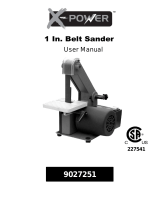
5
English
8. Use right tool.
Don’t force small tool or attachment to do the job
of a heavy-duty tool.
Don’t use tool for purpose not intended —for
example— don’t use circular saw for cutting tree
limbs or logs.
9. NEVER use a power tool for applications other
than those specified.
NEVER use a power tool for applications other than
those specified in the Instruction Manual.
10. Handle tool correctly.
Operate the tool according to the instructions
provided herein. Do not drop or throw the tool.
NEVER allow the tool to be operated by children,
individuals unfamiliar with its operation or
unauthorized personnel.
11. Keep all screws, bolts and covers tightly in place.
Keep all screws, bolts, and plates tightly mounted.
Check their condition periodically.
12. Do not use power tools if the plastic housing or
handle is cracked.
Cracks in the tool’s housing or handle can lead to
electric shock. Such tools should not be used until
repaired.
13. Blades and accessories must be securely mounted
to the tool.
Prevent potential injuries to youself or others.
Blades, cutting implements and accessories which
have been mounted to the tool should be secure
and tight.
14. Keep motor air vent clean.
The tool’s motor air vent must be kept clean so
that air can freely flow at all times. Check for dust
build-up frequently.
15. Operate power tools at the rated voltage.
Operate the power tool at voltages specified on its
nameplate.
If using the power tool at a higher voltage than
the rated voltage, it will result in abnormally fast
motor revolution and may damage the unit and
the motor may burn out.
16. NEVER use a tool which is defective or operating
abnormally.
If the tool appears to be operating unusually,
making strange noises, or otherwise appears
defective, stop using it immediately and arrange
for repairs by a Hitachi authorized service center.
17. NEVER leave tool running unattended. Turn power
off.
Don’t leave tool until it comes to a complete stop.
18. Carefully handle power tools.
Should a power tool be dropped or struck against
hard materials inadvertently, it may be deformed,
cracked, or damaged.
19. Do not wipe plastic parts with solvent.
Solvents such as gasoline, thinner benzine, carbon
tetrachloride, and alcohol may damage and crack
plastic parts. Do not wipe them with such solvents.
Wipe plastic parts with a soft cloth lightly
dampened with soapy water and dry thoroughly.
20. ALWAYS wear eye protection that meets the
requirement of the latest revision of
ANSI Standard Z87.1.
21. Align the inside arrow mark of the sanding belt
with the revolving direction of the drive pulley.
22. Sanding by applying impact and cutting by side-
of-belt contact should be avoided.
23. Be careful of sanding sparks.
24. After operation sweep the sanding dust from the
dust bag to avoid serious accidents.
25. Don't use water, or oil as lubricant.
26. Ascertain that the sanding workpiece contains
neither nails nor other harmful foreign matter.
27. Sanding glass fiber not recommended.
28. After operation, blow away the dust on the belt
and the pulleys.
29. Definitions for symbols used on this tool
V ............... volts
Hz ............. hertz
A ............... amperes
n
o .............. no load speed
W .............. watt
............. Class II Construction
---/min ...... revolutions or reciprocation per minute
............. Alternating current
DOUBLE INSULATION FOR SAFER
OPERATION
To ensure safer operation of this power tool, HITACHI
has adopted a double insulation design. “Double
insulation” means that two physically separated
insulation systems have been used to insulate the
electrically conductive materials connected to the power
supply from the outer frame handled by the operator.
Therefore, either the symbol “ ” or the words “Double
insulation” appear on the power tool or on the nameplate.
Although this system has no external grounding, you
must still follow the normal electrical safety precautions
given in this Instruction Manual, including not using the
power tool in wet environments.
To keep the double insulation system effective, follow
these precautions:
䡬
Only HITACHI AUTHORIZED SERVICE CENTER
should disassemble or assemble this power tool,
and only genuine HITACHI replacement parts
should be installed.
䡬
Clean the exterior of the power tool only with a
soft cloth moistened with soapy water, and dry
thoroughly.
Never use solvents, gasoline or thinners on plastic
components; otherwise the plastic may dissolve.














